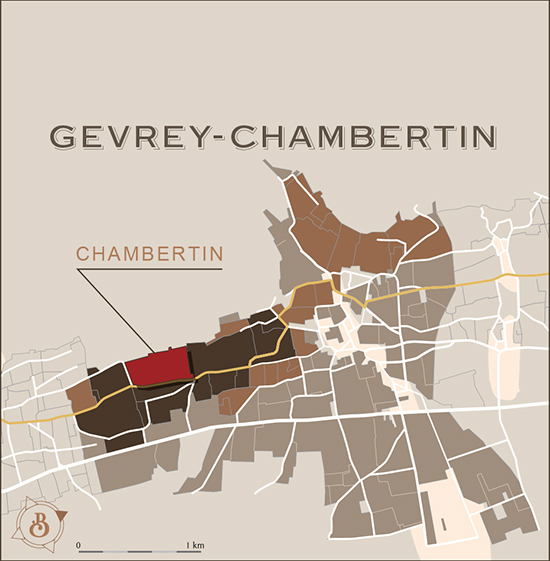Chambertin
Grand Cru 2017
'Chambertin, king of wines and wines of kings'
Origin
Gevrey-Chambertin is a large village located at the northern extremity of the Côte de Nuits. It boasts one of the largest surface areas under vine with no less than 330 hectares under production, of which 13 ha are classified as Chambertin. There are no fewer than 55 different parcels here. The Grand Cru terroirs begin south of the village where the eastern exposure is ideal, allowing the vines to benefit from the rising sun at an altitude of approximately 250 m. In Burgundy, the names of wines are often derived from the name of the land’s former proprietor which is attached to a common noun (champ, clos, meix). In this case, Chambertin refers to the field (champ) of a certain Bertin.
Viticulture
Grape variety: pinot noir
Soils: generous soil of deep marls and hard Bathonian limestone mixed with stony debris.
Orientation: East
Surface area under vine: 0,15 ha
Pruning: Guyot system
Yield: 35hL/ha
Average age of the vines: 45 years old.
Vinification
Harvest date: 16th of September 2017.
The grapes were handpicked. They were sorted a first time in the vineyard and a second time on the sorting table when they arrived at the winery.
At the winery: the grapes were 100% destemmed but not crushed (they were left whole) and were gravity-fed into tanks. Maceration lasted a total of 20 days including 4 days of cold maceration (12°C). Fermentation used indigenous yeasts only (no additives such as enzymes or tannins were used).3 punchings of the cap.
Ageing
Maturation: aged on the lees for 18 months with no racking using 100% of new French oak barrels.
Barrels: French oak barrels that had been toasted at low temperatures for a long time to impart a very delicate touch of oak to the wine.
Bottling
Bottling: The wine was very gently filtered before being bottled in May 2019.
Number of bottles : 600.
Vintage
2017, finesse
The growing cycle was thrown off-kilter by a very cold winter, late spring frost, then optimal conditions for rapid flowering, sporadic hail, and summer drought. Harvesting began in early September in the sun, and after several lean years, the vines finally produced abundant grapes, although with significant differences in maturity between whites and reds and from one region to another, which called for strict sorting.
Ageing potential: 10 years and more.
Tasting notes
With a scarlet and brilliant color, this wine reveals aromas of flowers and liquorice. The mouth is powerful, quite fat with very silky tannins.



